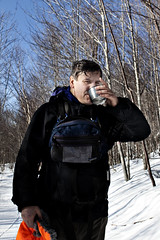lx93
New member
- Joined
- Sep 19, 2005
- Messages
- 301
- Reaction score
- 14
Ideally, I'd like to get a DSLR case (separate from the backpack) that I could strap onto chest height and put the camera in w/ the lens facing upwards, i.e., NOT a top-loader.
Any ideas?
FWIW, I shoot w/ a Nikon D300 w/ 16-85mm & 70-300mm glass.
Answers to "Why not...?" questions:
1)
Why not a belly-pack?
They make it harder to breathe when going up a steep section. At least enough that it slows you down. I know from when I used this Inverse 200 AW; very well-constructed, and allows the lens to face up. Otherwise a great product.
http://products.lowepro.com/product/Inverse-200-AW,2101,7.htm
2)
Why not a top-loader?
-Putting a zoom lens face-down can damage the zoom gears if it flops enough.
I used this M-Rock top-loader- again, a great design, but...
http://www.m-rock.com/sierra-digital-slr-bags.html
3)
Why not a backpack designed mostly for photography w/ a tiny section for hiking gear?
-I'd have to take off the pack every time I wanted to get a shot.
-15 to 20-mile hikes during the week means I'm usually going solo & have to take enough gear (25-ish pounds/10 kg) to survive in case I'm out there overnight and can't do a Beck Weathers or Joe Simpson.
Any ideas?
FWIW, I shoot w/ a Nikon D300 w/ 16-85mm & 70-300mm glass.
Answers to "Why not...?" questions:
1)
Why not a belly-pack?
They make it harder to breathe when going up a steep section. At least enough that it slows you down. I know from when I used this Inverse 200 AW; very well-constructed, and allows the lens to face up. Otherwise a great product.
http://products.lowepro.com/product/Inverse-200-AW,2101,7.htm
2)
Why not a top-loader?
-Putting a zoom lens face-down can damage the zoom gears if it flops enough.
I used this M-Rock top-loader- again, a great design, but...
http://www.m-rock.com/sierra-digital-slr-bags.html
3)
Why not a backpack designed mostly for photography w/ a tiny section for hiking gear?
-I'd have to take off the pack every time I wanted to get a shot.
-15 to 20-mile hikes during the week means I'm usually going solo & have to take enough gear (25-ish pounds/10 kg) to survive in case I'm out there overnight and can't do a Beck Weathers or Joe Simpson.
Last edited:




